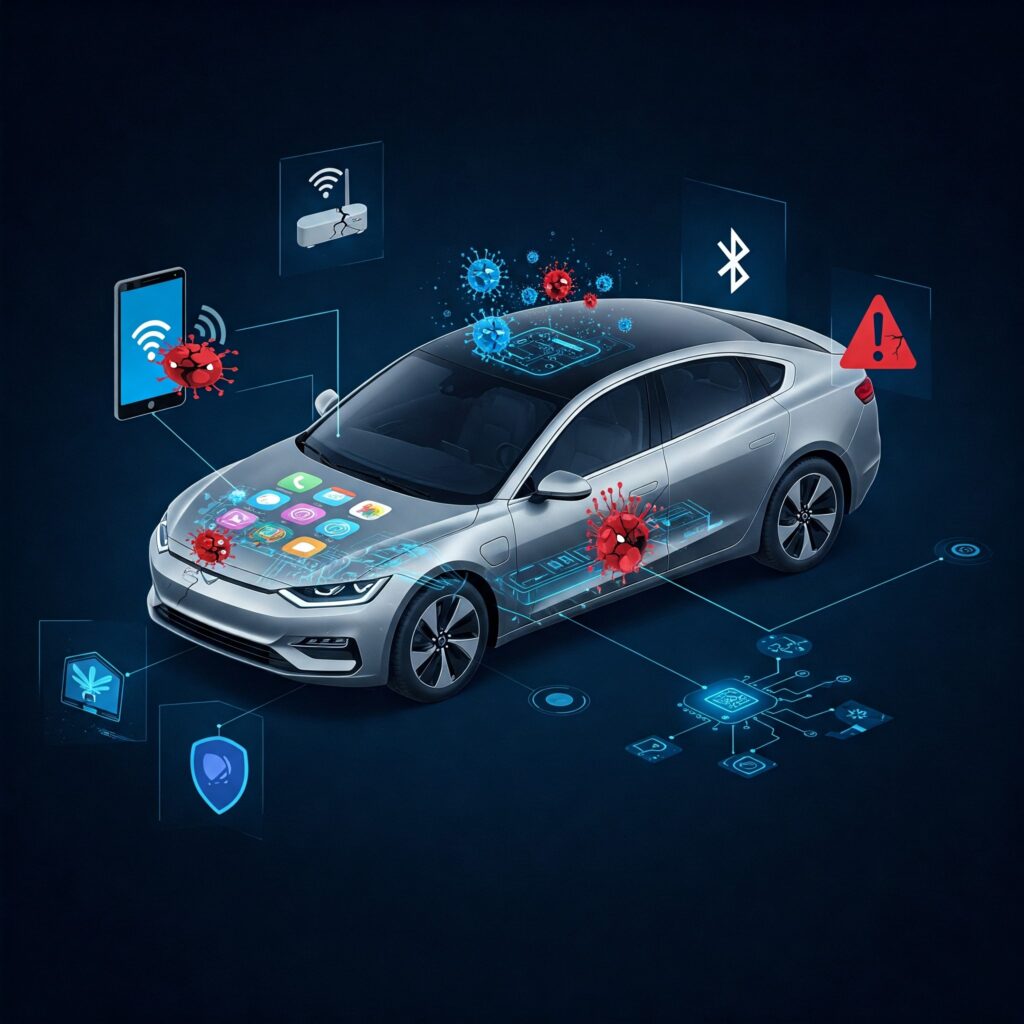By Brandon Barry
As electric vehicles become increasingly connected, protecting them from cybersecurity threats is no longer optional—it’s essential. In fact, in 2025 alone, over 60% of EV cybersecurity vulnerabilities were found in infotainment and telematics systems, highlighting unexpected weak points in the vehicle ecosystem. From navigating fast-evolving regulations, to recognizing cyber-attack symptoms, to establishing clear response protocols, EV manufacturers, system developers, and technicians face critical challenges in securing modern vehicles. This article breaks down what automotive cybersecurity really involves and offers practical guidance to help you implement, manage, and future-proof secure EV systems and services.
What Is Automotive Cybersecurity and Why It Matters
Automotive cybersecurity is the defense of connected vehicles and their systems from cyber threats. The goal is to “stay one step ahead of hackers” who aim to exploit vulnerabilities for financial gain or disruption. Beyond protecting passengers, cybersecurity helps preserve brand trust and asset value, particularly as EVs rely on apps, chargers, and connected services.
Common Misconceptions: Why It’s More Complex Than You Think
Many companies assume cybersecurity is a one-time install of antivirus-like software. However, modern EVs require continuous cybersecurity across the entire vehicle lifecycle. With vehicles on the road for 15+ years, solutions must anticipate future threats and involve coordination across OEMs, suppliers, and chip manufacturers. There’s no silver bullet—only a layered, collaborative approach.
The EV Cybersecurity Ecosystem: Who’s Responsible?
Cybersecurity isn’t just the job of automakers. It spans the entire automotive supply chain, from chipmakers to Tier 1 system providers. Every component—hardware and software—must meet regulatory and technical standards. Everyone within the value chain needs to play their part.
How Automotive Cybersecurity Works
Cybersecurity is embedded into each phase of vehicle development: design, implementation, testing, and ongoing monitoring. Because vehicles are connected to the internet, risk mitigation must be continuous and compliant with emerging regulations. Governments now view secure vehicle deployment as a matter of national and economic security.
Building Secure, Agile EV Systems
The biggest cybersecurity implementation shift? Agility. Software-defined vehicles introduce both new threats and new opportunities. Rapid response and adaptability are key to staying ahead of evolving risks. It is important to design vehicles to be resilient over years of use and constant digital change.
Real-World Threats: How EV Hacks Happen
EVs aren’t being hacked en masse today, but the signs are growing. In cases like the “Kia Boys” incident that copied keyless entry FOBs and used RF relay attacks, the vulnerabilities led to widespread car theft. Cloud-connected features like remote start and unlock are also potential entry points. Researchers have exposed gaps that automakers must now close before attackers exploit them.
From Detection to Action: Tools for Fast Threat Response
Block Harbor provides red and blue team support—offensive hackers who find vulnerabilities and defensive engineers who secure systems. Their Vehicle Security Engineering Cloud helps customers identify threats, map affected vehicles, and deploy fixes quickly, minimizing exposure windows.
What Makes a Strong Automotive Cybersecurity Framework?
Key features include:
- Built-in Security: Cybersecurity must start at design, not be bolted on later.
- Agility: The ability to respond rapidly to threats is more important than perfection.
- Seamless User Experience: Like an iPhone, the system should “just work” securely, without requiring user intervention.
The User’s Role in Automotive Cyber Hygiene
While automakers carry most of the burden, users should be cautious when modifying vehicles or installing third-party electronics. OEMs have taken steps to sandbox connections from devices like smartphones, but unintended risks can emerge from DIY upgrades or tuning.
What If Ransomware Hits a Vehicle?
While rare, a connected car ransomware attack would shift the burden to the automaker. Dealers or OTA systems would need to deploy fixes. The danger is not in the attack itself, but in being unprepared to act when it happens.
Implementation Timeframes and Hidden Benefits
Implementing full-scale automotive cybersecurity takes years, especially with new standards and regulations. But benefits go beyond compliance. Cybersecurity protects recurring revenue (e.g., in-car subscriptions), builds customer trust, and strengthens brand positioning in a competitive EV market.
Cybersecurity Training and the Role of Dealers
Ideally, technicians and dealers shouldn’t need to become cybersecurity experts. However, as vehicle service tools become remotely accessible, all parties must understand their roles and responsibilities to maintain a secure environment.
Future-Proofing EV Architectures
Cybersecurity is forcing automakers to move away from outdated vehicle platforms. While newer architectures are generally well-designed for security, the landscape evolves quickly. Automotive cybersecurity critically needs proactive investment and continuous improvement.
Available Resources for EV Cybersecurity Professionals
To stay informed, professionals can explore:
- Block Harbor – blockharbor.io
- Automotive Security Research Group (ASRG) – asrg.io
- Auto-ISAC – A hub for industry-wide threat intelligence and collaboration
Conclusion As EVs grow smarter and more connected, the attack surface expands. Automakers and their partners must embrace a culture of security that spans design, implementation, and long-term service. With the right tools, training, and partnerships, the EV industry can stay one step ahead of threats and deliver safe, reliable, and secure connected vehicles to customers worldwide.
About Brandon Barry
Brandon Barry is the CEO and founder of Block Harbor Cybersecurity, leading a team dedicated to safeguarding automotive systems against cyber threats. With a background in computer engineering from Brown University, Brandon’s expertise encompasses offensive security testing, car hacking, and defensive strategies utilizing data science for anomaly detection.


